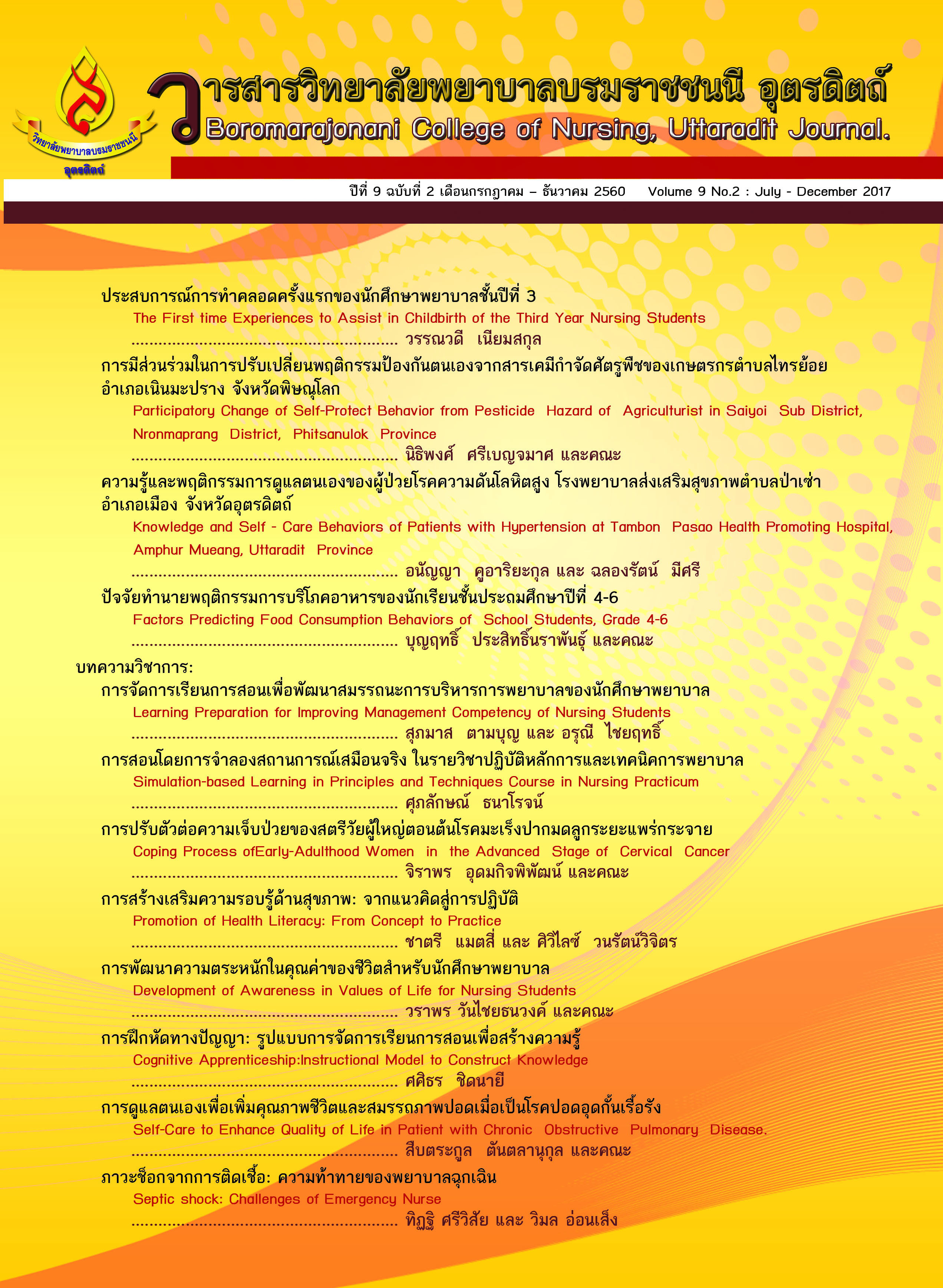ภาวะช็อกจากการติดเชื้อ: ความท้าทายของพยาบาลฉุกเฉิน
Main Article Content
บทคัดย่อ
Septic shock is an urgent condition commonly occurred in an emergency room. It is a major public health problem due to the rapid onset of the critical disease and high mortality rate. Professional nurses who work in the emergency room are important frontline personnel to care for patients with septic shock at all stages of treatment including screening, assessment, symptoms monitoring also coordinated with multidisciplinary care team and also refer patients to the various departments asappropriate. This role is a challenge of emergency nurses to develop their knowledge and develop
skill in advanced nursing in dealing with septic shock. The main goal is to provide safely care for the patient from the septic shock as soon as possible until the circulatory system returns to normal, reduces disability andsurvived from their critical conditions of patients.
Article Details
บทความหรือข้อคิดเห็นใดใดที่ปรากฏในวารสารวิจัยการพยาบาลและวิทยาศาสตร์สุขภาพ เป็นวรรณกรรมของผู้เขียน ซึ่งบรรณาธิการหรือสมาคมศิษย์เก่า ไม่จำเป็นต้องเห็นด้วย และบทความที่ได้รับการตีพิมพ์เผยแพร่ถือเป็นลิขสิทธิ์ของวารสารวิจัยการพยาบาลและวิทยาศาสตร์สุขภาพ
References
2. Dellinger, P.R., Schorr, A.C., Levy, M.M. (2017). A user’s guide to the 2016 surviving sepsis gulide lines. Intensive care medicine. 43, 229-303.
3. Karakala, N., Raghunathan, K., Shaw, D.,and Andrew. (2013). Intravenous fluids in sepsis: What to use and what to avoid. Current opinion in critical care. 19. 537-43.
4. Onswadipong, P., Sungkard, K., Kusumanaayuthya., S., and Rongrungruan, Y. (2011). The effect of early goal-directed nursing intervention on severityo for ganfailureinpatients with sepsis syndrome. journal of nursing science. 29(2), 102-110
5. Paterson, R.L., Webster, N.R. (2000). Sepsis and the systemic inflammatory response syndrome .Journal of the Royal college of surgeons of Edinburgh, 45(3), 178-182.
6. Phoempikun, C. (2012). First hour in emergency room the practical approach 2012. Bangkok: Paliving printing. (In Thai)
7. Pollard, S., Edwin, S. B., & Alaniz, C. (2015). Vasopressor and Inotropic Management of Patients with septic shock. Pharmacy and The rapeutics, 40(7), 438–450.
8. Pornsirirat, T., et al. (2015). Factors predicting sepsis shock in septic aemic medical patient. Thai journal of nursing council. 30(1), 72-85.
9. Pornsirirat, T. (2015). Septic Shock. In Naowapanich,. S., and Pinyopasakul,. W. (ed.),Criticalcare : medicalnursing. Bangkok: Parbpim Ltd.
10. Rhodes, A., et al. (2017). Surviving sepsis campaign: international guidelines for management of sepsis and septic shock 2016. Intensive care medicine, 43, 304-377.
11. Srivisai, T., Pinyopasakul, W., Charoenkitkarn. V. (2015). Relationships between age,body mass index, comorbidity, and systemic in flammatory response syndrome in patients with respiratory in fection an emergency unit. Ramathibodinursing journal, 21(2), 186-198.
12. Wang, H.E., Shapiro, N.I., Angus, D.C., Yealy, D.M . (2007).National estimates of severe sepsis in United States emergency departments.Critical care medicine, 35(8), 1928-1936
13. World Health Organization. (2016). Global health estimates 2015 summary table. Retrieved 7 September, 2017, from http://www.who.int/healthinfo/global_burden_disease/estimates/en/index1.html

